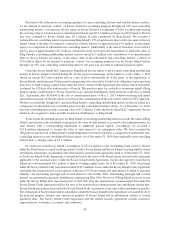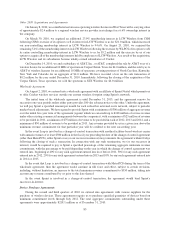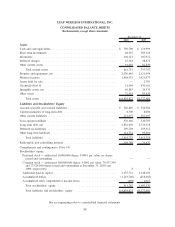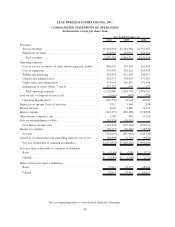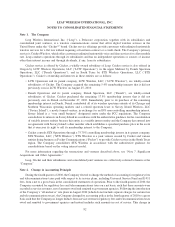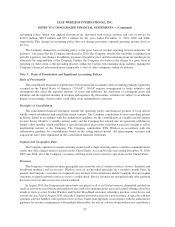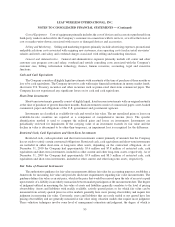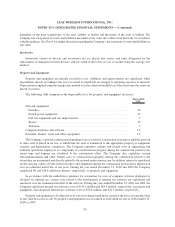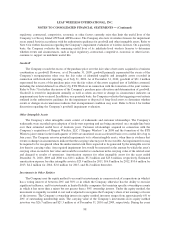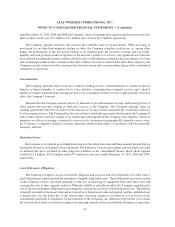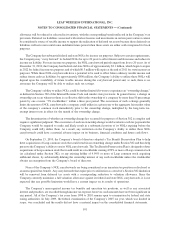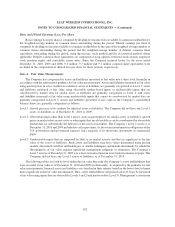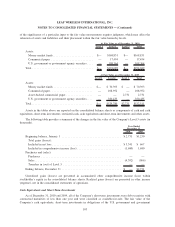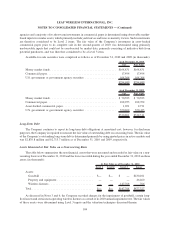Cricket Wireless 2010 Annual Report Download - page 100
Download and view the complete annual report
Please find page 100 of the 2010 Cricket Wireless annual report below. You can navigate through the pages in the report by either clicking on the pages listed below, or by using the keyword search tool below to find specific information within the annual report.multiple element arrangement. Under this guidance, once a company has determined the fair value of the elements
in the sales transaction, the total consideration received from the customer must be allocated among those elements
on a relative fair value basis. Applying the guidance to these transactions results in the Company recognizing the
total consideration received, less amounts allocated to the wireless service period (generally the customer’s monthly
rate plan), as equipment revenue.
Amounts allocated to equipment revenues and related costs from the sale of devices are recognized when
service is activated by new customers. Revenues and related costs from the sale of accessories and upgrades for
existing customers are recognized at the point of sale. The costs of devices and accessories sold are recorded in cost
of equipment. In addition to devices that the Company sells directly to its customers at Cricket-owned stores, the
Company sells devices to third-party dealers, including mass-merchant retailers. These dealers then sell the devices
to the ultimate Cricket customer, similar to the sale made at a Cricket-owned store. Sales of devices to third-party
dealers are recognized as equipment revenues only when service is activated by customers, since the level of price
reductions and commissions ultimately available to such dealers is not reliably estimable until the devices are sold
by such dealers to customers. Thus, revenues from devices sold to third-party dealers are recorded as deferred
equipment revenue and the related costs of the devices are recorded as deferred charges upon shipment by the
Company. The deferred charges are recognized as equipment costs when the related equipment revenue is
recognized, which occurs when service is activated by the customer.
Through a third-party provider, the Company’s customers may elect to participate in an extended warranty
program for devices they purchase. The Company recognizes revenue on replacement devices sold to its customers
under the program when the customer purchases the device.
Sales incentives offered to customers and commissions and sales incentives offered to the Company’s third-
party dealers are recognized as a reduction of revenue when the related service or equipment revenue is recognized.
Customers have limited rights to return devices and accessories based on time and/or usage, and customer returns of
devices and accessories have historically been insignificant.
Amounts billed by the Company in advance of customers’ wireless service periods are not reflected in
accounts receivable or deferred revenue since collectability of such amounts is not reasonably assured. Deferred
revenue consists primarily of cash received from customers in advance of their service period and deferred
equipment revenue related to devices sold to third-party dealers.
Universal Service Fund, E-911 and other telecommunications-related regulatory fees are assessed by various
federal and state governmental agencies in connection with the services that the Company provides to its customers.
As discussed in Note 2, during the fourth quarter of 2010, the Company changed the method of accounting for
regulatory fees and telecommunications taxes from a net to a gross basis. Regulatory fees and telecommunications
taxes collected from customers are recorded in service revenues and amounts owed and remitted to government
agencies are recorded in cost of service.
Costs and Expenses
The Company’s costs and expenses include:
Cost of Service. The major components of cost of service are: charges from other communications
companies for long distance, roaming and content download services provided to the Company’s customers;
charges from other communications companies for their transport and termination of calls originated by the
Company’s customers and destined for customers of other networks; expenses for tower and network facility rent,
engineering operations, field technicians and utility and maintenance charges, and salary and overhead charges
associated with these functions; and regulatory fees and telecommunications taxes, including Universal Service
Fund and E-911 fees.
94
LEAP WIRELESS INTERNATIONAL, INC.
NOTES TO CONSOLIDATED FINANCIAL STATEMENTS — (Continued)


